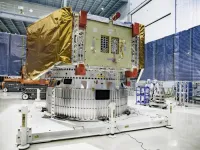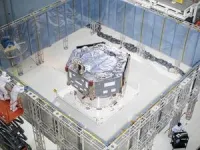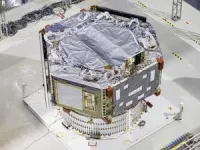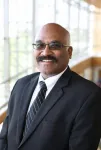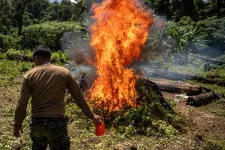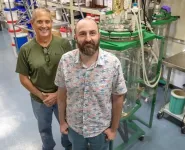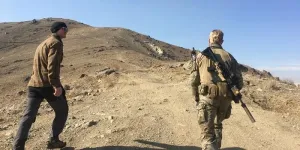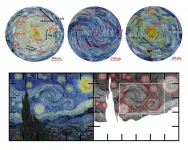(Press-News.org)
The spacecraft bus that will deliver NASA’s Nancy Grace Roman Space Telescope to its orbit and enable it to function once there is now complete after years of construction, installation, and testing.
Now that the spacecraft is assembled, engineers will begin working to integrate the observatory’s other major components, including the science instruments and the telescope itself.
“They call it a spacecraft bus for a reason — it gets the telescope to where it needs to be in space,” said Jackie Townsend, the Roman deputy project manager at NASA’s Goddard Space Flight Center in Greenbelt, Maryland. “But it’s really more like an RV because it has a whole assortment of functions that enable Roman to accomplish its scientific goals while out there too.”
Those goals include surveying wide swaths of the universe to study things like: dark energy, a mysterious cosmic pressure thought to accelerate the universe’s expansion; dark matter, invisible matter seen only via its gravitational influence; and exoplanets, worlds beyond our solar system.
The mission’s science wouldn’t be possible without a spacecraft to transport the telescope, point the observatory toward different cosmic targets, provide power, communicate with Earth, control and store instrument data, and regulate Roman’s temperature. Nearly 50 miles of electrical cabling are laced throughout the assembly to enable different parts of the observatory to communicate with each other.
The spacecraft will also deploy several major elements that will be stowed for launch, including the solar panels, deployable aperture cover, lower instrument Sun shade, and high-gain antenna. It’s also responsible for collecting and beaming down data, which is no small task for a space observatory that will survey the cosmos like Roman will.
“Roman will send back 1.4 terabytes of data per day, compared to about 50 to 60 gigabytes from the James Webb Space Telescope and three gigabytes from the Hubble Space Telescope,” said Jason Hylan, the Roman observatory manager at NASA Goddard. “Webb’s daily downlink is roughly comparable to 13 hours of YouTube video at the highest quality while Roman’s would amount to about 2 weeks.”
A Goddard Grand Slam
This milestone is the culmination of eight years of spacecraft design work, building, and testing by hundreds of people at Goddard.
“Goddard employees were the brains, designers, and executors. And they worked with vendors who supplied all the right parts,” Townsend said. “We leaned on generations of expertise in the spacecraft arena to work around cost and schedule challenges that arose from supply chain issues and the pandemic.”
One time- and money-saving technique the team came up with was building a spacecraft mockup, called the structural verification unit. That allowed them to do two things at once: complete strength testing on the mockup, designed specifically for that purpose, while also assembling the actual spacecraft.
The spacecraft’s clever layout also allowed the team to adapt to changing schedules. It’s designed to be modular, “more like Trivial Pursuit pie pieces than a nesting egg, where interior components are buried inside,” Townsend said. “That’s been a game-changer because you can’t always count on things arriving in the order you planned or working perfectly right away with no tweaks.” It also increased efficiency because people could work on different portions of the bus at the same time without interfering with each other.
The slightly asymmetrical and hexagonal spacecraft bus is about 13 feet (4 meters) wide by 6.5 feet (2 meters) tall and weighs in at 8,400 pounds (3,800 kilograms).
One reason it doesn’t weigh more is that some components have been partially hollowed out. If you could peel back some of the spacecraft’s panels, you’d find superthin metallic honeycomb sandwiched between two slim layers of metal. And many of the components, such as the antenna dish, are made of strong yet lightweight composite materials.
When the spacecraft bus was fully assembled, engineers conducted a comprehensive performance test. Prior to this, each component had been tested individually, but just like with a sports team, the whole unit has to perform well together.
“The spacecraft passed the test, and now we’re getting ready to install the payload –– Roman’s instruments and the telescope itself,” said Missie Vess, a spacecraft systems engineer for Roman at NASA Goddard. “Next year, we’ll test these systems together and begin integrating the final components of the observatory, including the deployable aperture cover, outer barrel assembly, and solar panels. Then we’ll finally have ourselves a complete observatory, on track for launch by May 2027.”
END
NASA completes spacecraft to transport, support Roman Space Telescope
2024-09-17
ELSE PRESS RELEASES FROM THIS DATE:
University of Health Sciences earns $5.3 million from NIH to boost cancer research, support emerging scientists
2024-09-17
A $5.3 million National Institutes of Health grant awarded to the University of Oklahoma Health Sciences will support advanced cancer research in Oklahoma. The Centers of Biomedical Research Excellence (COBRE) grant is designed to build research capacity and help early-career researchers establish independently funded laboratories.
This is the third and final phase of the COBRE grant, which was first awarded in 2012, followed by phase two in 2017. The grant has supported and paralleled the growth of OU Health Stephenson Cancer Center, Oklahoma’s ...
Central America could play troubling new role in cocaine trade
2024-09-17
COLUMBUS, Ohio – For many decades, the coca plant – the main ingredient in cocaine – has been grown almost exclusively in South America. But a new study shows that nearly half of northern Central America appears to be highly suitable for cultivating this lucrative cash crop.
Findings showed that 47% of Honduras, Guatemala and Belize have the right climate and soil for commercial coca growing. Most of southern Central America was not suitable.
It’s not a hypothetical concern. Researchers began ...
SwRI and UTSA will create synthetic process for antibiotic drug discovery
2024-09-17
SAN ANTONIO — September 17, 2024 —Southwest Research Institute (SwRI) is collaborating with The University of Texas at San Antonio (UTSA) to explore and develop a novel platform or chemical process for synthesizing antibiotic compounds with a $125,000 grant. The project, one of two winning proposals this cycle, is supported by the Connecting through Research Partnerships (Connect) program designed to foster collaboration between SwRI and UTSA.
“SwRI and UTSA will work together to combat the growing threat antimicrobial resistance poses to global health by developing a proof-of-concept platform to potentially create a whole ...
Norwegian Afghanistan veterans more prone to anger
2024-09-17
From 2001 to 2021, roughly 9200 Norwegian soldiers served in Afghanistan. The vast majority of them have managed well in the years that have followed. According to a new survey conducted by the Norwegian Armed Forces Joint Medical Services, however, a significant number of the veterans struggle with mental health issues.
“All Norwegian veterans who served in Afghanistan were invited to participate in a large health survey in 2020,” says Associate Professor Andreas Espetvedt Nordstrand at the Norwegian University of Science and Technology ...
Black hole pairs may unveil new particles
2024-09-17
In a paper published in Physical Review Letters this week, physicists from Amsterdam and Copenhagen argue that close observations of merging black hole pairs may unveil information about potential new particles. The research combines several new discoveries made by UvA scientists over the past six years.
Gravitational waves that are emitted by the merger of two black holes carry detailed information about the shape and evolution of the orbits of the components. A new study by physicists Giovanni Maria Tomaselli and Gianfranco Bertone from ...
Amsterdam UMC led research sets a step forward in the battle against MRSA
2024-09-17
Staphylococcus aureus, mostly known from its antibiotic-resistant variant Methicillin-resistant Staphylococcus aureus (MRSA), is among the leading causes of both community- and hospital-acquired infections. According to the most recent data, MRSA killed around 120,000 people in 2022 globally and far more are killed by antibiotic-susceptible strains of S. aureus. So far however, all attempts at developing a protective vaccine for S. aureus have been unsuccessful. Research from Amsterdam UMC, in collaboration with UMC Utrecht, Leiden University, and the University of California, San Diego, have discovered an important immune component that offers protection against infection, ...
Childhood trauma linked to major biological and health risks
2024-09-17
A new study led by UCLA Health found that a person’s sex and their unique experiences of childhood trauma can have specific consequences for their biological health and risk of developing 20 major diseases later in life.
Although a large body of research has shown that childhood adversity can have long-lasting impacts on a person’s biology and health, there has been little research looking into how different types of stressors affect specific biological functions and health risks.
The new findings, published in the journal ...
Beneath the brushstrokes, van Gogh’s sky is alive with real-world physics
2024-09-17
WASHINGTON, Sept. 17, 2024 – Vincent van Gogh’s painting “The Starry Night” depicts a swirling blue sky with yellow moon and stars. The sky is an explosion of colors and shapes, each star encapsulated in ripples of yellow, gleaming with light like reflections on water.
Van Gogh’s brushstrokes create an illusion of sky movement so convincing it led atmospheric scientists to wonder how closely it aligns with the physics of real skies. While the atmospheric motion in the painting cannot be measured, the brushstrokes can.
In an article published this week in Physics ...
Excess body weight and the risk of second primary cancers among cancer survivors
2024-09-17
About The Study: In this cohort study of older survivors of nonmetastatic cancer, those who had overweight or obesity at the time of their first cancer diagnosis were at higher risk of developing a second cancer, especially an obesity-related second cancer. Given the high prevalence of overweight and obesity among cancer survivors, it is important to promote survivorship care guidelines recommending weight management and increase awareness of second cancers among physicians and cancer survivors.
Corresponding author: To contact the corresponding author, Clara Bodelon, Ph.D., M.S., email clara.bodelon@cancer.org
To access the embargoed study: Visit our For The ...
Outcomes by race and ethnicity following a Medicare bundled payment program for joint replacement
2024-09-17
About The Study: This cohort study shows that the Comprehensive Care for Joint Replacement program outcomes differed by race and ethnicity for patients covered outside traditional Medicare, with home discharge rates increasing more for Hispanic compared with non-Hispanic white patients. These findings suggest the importance of considering differential outcomes of Medicare payment policies for racial and ethnic minority patient populations beyond the initially targeted groups.
Corresponding author: To contact the corresponding author, Narae Kim, Ph.D., ...
